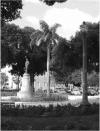Abstract
This article deals with the Historical Gardens in the city of Natal and ponders: Why do attempts to revitalize our historicalcenter not reach their goals? Why are public open areas abandoned by the population, so that they start deterioratingagain? The study tries to identify, to recognize and to alert for the necessity to preserve the Historical Gardens, tryingto be effective guaranteeing that the historical and cultural landscape remains and will be available for future generations.In order to give an account of history through its urban prints, our research stands between history of everydaylife and cultural geography, choosing culture – ways of life, habits, sense of identity and everyday life– as a componentof the relations between man and the space that surrounds him. Therefore, a historiographic reconstruction was carriedout, using photographic records and literary descriptions, to turn previous morphologic compositions into virtualreality. The procedure shall be adopted in eight parks, previously identified as Natal’s Historical Gardens. The caseof Augusto Severo Square, covered here, deals with a previous restoration during which a large esplanade was built,lacking vegetation and inappropriate given local climate and habits. Since the opportunity of cultural rescue has beenlost, at this moment, we expect that the area will recover its place in people’s memory and daily life.Apuntes is registered under a Creative Commons Attribution 4.0 International Public License. Thus, this work may be reproduced, distributed, and publicly shared in digital format, as long as the names of the authors and Pontificia Universidad Javeriana are acknowledged. Others are allowed to quote, adapt, transform, auto-archive, republish, and create based on this material, for any purpose (even commercial ones), provided the authorship is duly acknowledged, a link to the original work is provided, and it is specified if changes have been made. Pontificia Universidad Javeriana does not hold the rights of published works and the authors are solely responsible for the contents of their works; they keep the moral, intellectual, privacy, and publicity rights.
Approving the intervention of the work (review, copy-editing, translation, layout) and the following outreach, are granted through an use license and not through an assignment of rights. This means the journal and Pontificia Universidad Javeriana cannot be held responsible for any ethical malpractice by the authors. As a consequence of the protection granted by the use license, the journal is not required to publish recantations or modify information already published, unless the errata stems from the editorial management process. Publishing contents in this journal does not generate royalties for contributors.


